
This company was established with the support of TÜBİTAK for the project applied by inventor Nadir AKSOY with her 3 patented inventions.
This company was established for the purpose of producing my Ecological, Sustainable Performance, Orbital Mechanisms (ESPOM) inventions (TR 2017 22869 B, TR 2018 02873 B, TR 2018 05173 B, TR 2021 020251 B). These mechanisms can be used as an internal combustion engine that can also work with environmentally friendly, renewable alternative fuels. At the same time, it can also be used as a compressed air-powered engine in the field of transportation in the form of a non-combustible mechanism, in the form of a wind turbine in the fields of electricity generation and energy storage, and as a compressor engine with high energy efficiency in these three areas.
In conventional reciprocating compressors, the crankshaft is not an efficient part in converting circular motion into linear motion. Especially when approaching the dead spots where the compression pressure is highest, it causes the efficiency to decrease. For this reason, the use of a crankshaft causes a significant amount of energy loss in these systems.
The purpose of the patent-approved invention is to develop a more compact and efficient compressor than existing compressors by designing a compressor without an air tank and crankshaft. The mechanism to be produced is designed in a different kinematic/mechanical system format, making it possible to transmit the thrust force directly to the piston towards the end of the compression process without using a crankshaft.
In addition, the need for compressed air at a constant flow rate in reciprocating compressors is provided by external large and costly tanks. In this invention; a small stabilizer has been designed with a very small volume that balances the air pressure. Thus, non-ergonomic problems such as production costs, stocking problems, difficulty working with tanks have also been solved.
https://www.linkedin.com/company/77649112
https://www.linkedin.com/in/inventor-nadir-aksoy
https://www.linkedin.com/groups/13948018
The first prototype manufacture of EPSOM mechanisms is underway.
ECOLOGICAL, SUSTAINABLE PERFORMANCE, ORBITAL MOTOR
HIGH TORQUE GENERATING MECHANISM AND INTERNAL COMBUSTION, ROTARY ENGINE
INTERNAL / EXTERNAL COMBUSTION ENGINE, DRONE, AIRCRAFT, LAND AND MARINE VEHICLE ENGINE, WITH PISTON-DRIVEN ROTORS, HIGH ENERGY EFFICIENCY AND HIGH TORQUE VALUE TURNING LINEAR / CIRCULAR MOTION INTO EACH OTHER, COMPRESSED AIR ENGINE, COMPRESSOR
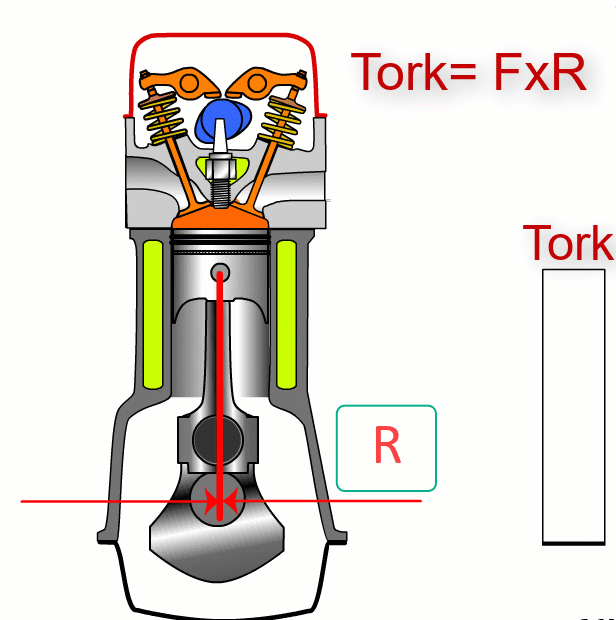
When the pressure is highest in internal combustion engines where the crankshaft is used, the angle value between the piston and the output shaft is about 10-15 degrees. Thus, the pressure obtained according to the formula cannot fully affect the torque value of the engine.
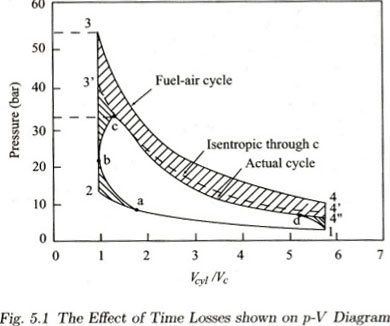
In conventional internal combustion piston and rotary engines, the combustion stroke begins towards the end of the compression stroke and continues until sometime after the start of the power stroke. The combustion stroke cannot be applied independently of the four strokes. Because of this disadvantage, the friction force increases a lot, mechanical efficiency, thermal efficiency, and emission values deteriorate, and accordingly, the overall efficiency decreases specific fuel consumption increases. In today’s developing engine technology (SkyActiv-X (SPCCI)), the reason for using the input ignition provided by the spark plug, when necessary, before the actual combustion is to make this combustion time as independent as possible.
In these internal combustion engine inventions, the internal rail and/or outer rail, which rotate with each other in certain proportions and different directions, used a cylinder block that harbors the cylinders and rotates in the same direction as the internal rail. The pistons in the cylinder block continue the cycle by moving to the outer rail after the inner rail, and then back to the inner rail. The Pistons rotate, acting on the periphery of these rails. The engine works with the pressure generated by the combustion of fuel mixed with air taken into the cylinders through the time shaft (1, 2).
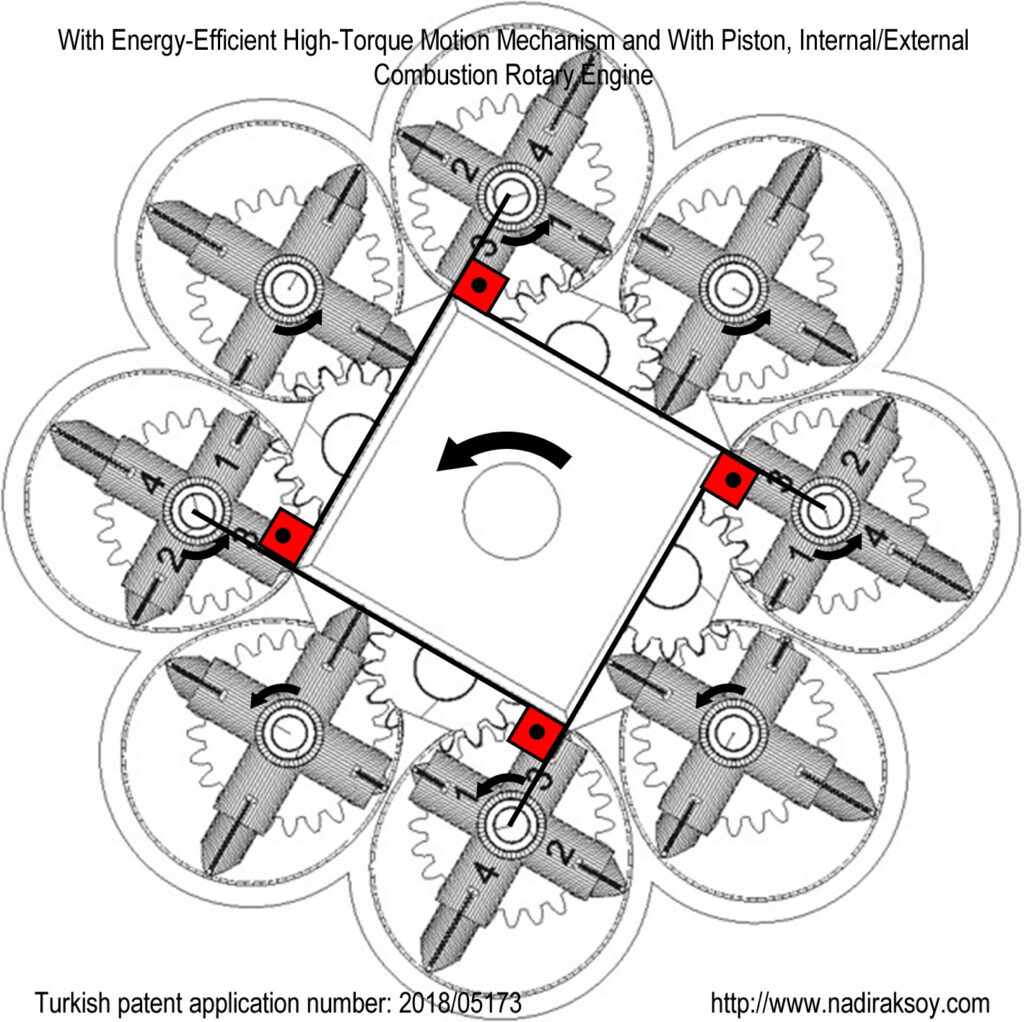
At the end of full combustion and the start of the power stroke, the angle value between the piston axis and the output shaft axis is much higher than in conventional motors. For this reason, much higher torque can be achieved than traditional internal combustion engines. In addition, during power and exhaust strokes and in the constant volume range where combustion occurs (on time), the piston always acts at an angle of 90 degrees to the rails. Also, at intake and compression strokes, there is an effect of 90 degrees. Thus, the piston-cylinder mechanism is only subjected to pressure axially.
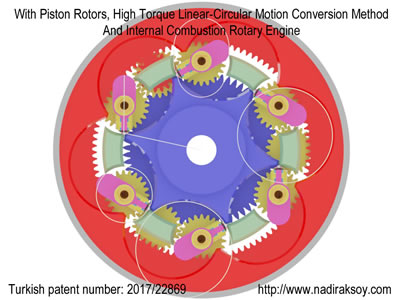
Since there is no part connected to the piston in these inventions, the speed of the piston can be changed in a certain amount and position. Combustion occurs in an independent stroke (at the time) of 30 degrees. In this stroke, the speed of the piston is zero. Complete combustion occurs in this volume and time. Thus, with a poor mixture well below the stoichiometric ratio thermal efficiency for all engine speeds can be much higher than conventional engines. The highest pressure obtained can be applied as the piston moves toward the lower dead point. In this sense, the expression independent three-stroke or five-stroke internal combustion engine can be used for these inventions. Thus, in compression ignition engines (CIDI, PCCI, HCCI, SPCCI), the combustion control problem has been solved with these inventions without using Spark Plugs.
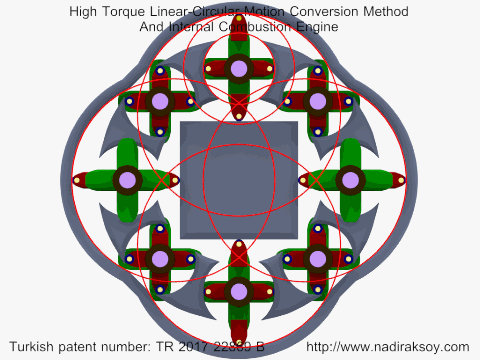
The compression ratio can be changed by changing the rail format.
The crankshaft is not a suitable part for converting the potential energy of fuel into kinetic energy. It causes a significant amount of torque and power loss when converting linear motion into circular motion. This, in turn, leads to more exhaust gas, costs, noise, labor, and weight than it should be.
Internal combustion rotary engines (Wankel etc.) and piston engines have two disadvantages due to the geometry of the crankshaft:
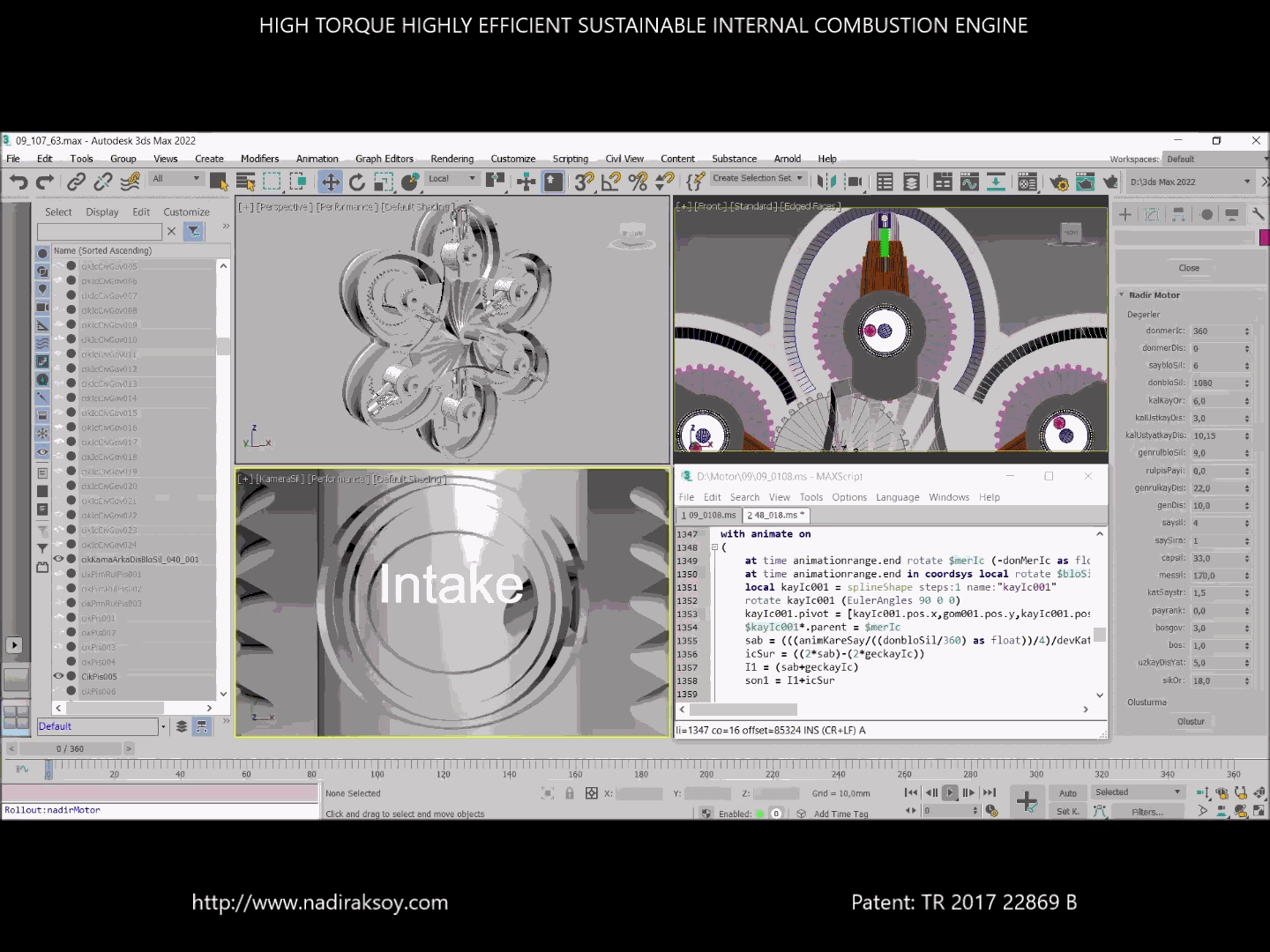
In designs which is use a crankshaft or are not used (at rotary engines) and converted to each other linear/circular motion at a given force effect, now of pressure, and/or linear/circular motion, the impact position is very close to the upper dead point. This means that the force cannot be converted to a sufficient torque value. Force, pressure, or moment effect can be applied at very low angles. The angle value between the piston axis and the crankshaft is 10-15 degrees at the beginning of the power stroke, when the maximum pressure value of the cycle occurs, while this angle value increases as the pressure value decreases. When the highest pressure value is formed, this angle should be as close to 90 degrees as possible. This negatively affects the torque value. In some of the inventions made to eliminate this problem, the pressure at the start of the power stroke was stored using the spring. The piston pressure is then applied to the connecting rod when the pressure angle increases by continuing to rotate the crankshaft. In some of these inventions, additional mechanisms were used with a connecting rod. The aim is again to affect the piston pressure on the connecting rod at the largest possible angle. In some of these inventions, the crankshaft was never used. However, in these designs, the problem mentioned below cannot be solved, and/or smooth (accurate) circular motion cannot be achieved.
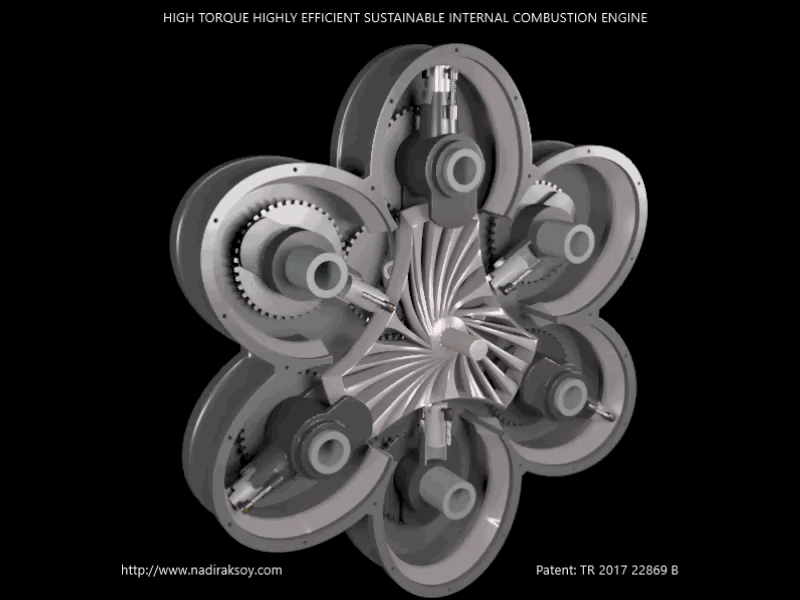
Conventional internal combustion piston and rotary engines do not have combustion strokes as a separate and independent fifth time from the four strokes formed by intake, compression, power, and exhaust strokes. The five strokes cannot be applied independently of each other, since the combustion stroke, which must be applied before the power stroke goes into other strokes, starts towards the end of the compression stroke, and continues until some stroke after the start of the power stroke. It does not allow enough time to complete combustion. Not enough time when the piston speed is zero. Thermodynamic losses occur due to the start of the combustion process before the piston has yet to reach the upper dead point.
Conventional internal combustion piston and rotary engines since there is no axial and smooth circular motion, there is vibration.
Because of all these disadvantages, friction power increases a lot, mechanical efficiency, thermal efficiency, emission values deteriorate, and accordingly, overall efficiency decreases, specific fuel consumption increases.
With this invention, these two problems are solved:
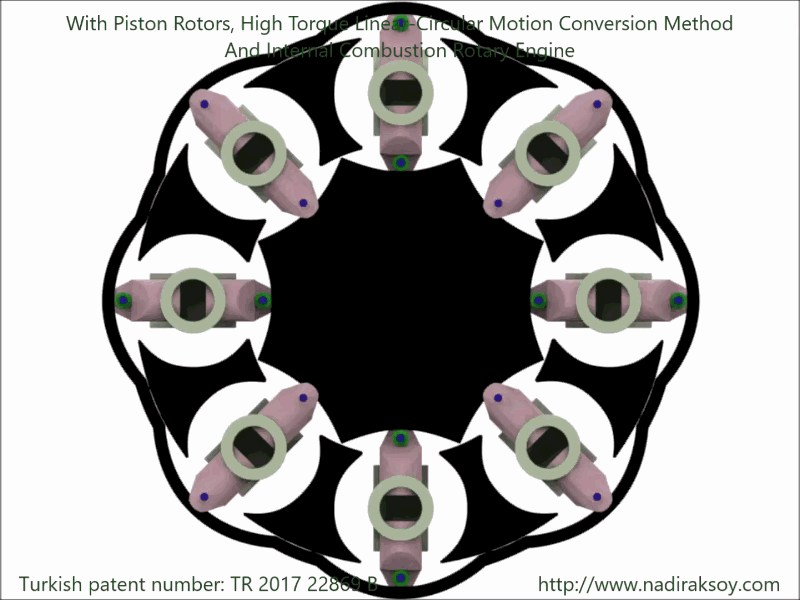
In this invention, a design without a crankshaft was made. Linear motion is translated into circular motion with a much higher torque value. At the beginning of the power stroke, when the pressure is highest, the torque angle is 90 degrees.
It has a combustion stroke independent of four strokes. There is constant volume stroke for the combustion process. During this time, the piston speed is zero. Combustion carried out at the specified fixed volume in the theoretical Otto cycle. The high pressure stored by complete combustion, which occurs in the process of constant volume (The piston speed is 0 while the output shaft continues to rotate.), is transferred to this rail with a high angle value when moving from fixed rail to an internal or external rail. Thus, the highest torque value is obtained. A very efficient cycle takes place. Due to full combustion, both the pressure increase rate and thermal efficiency are higher than conventional engines. Specific fuel consumption and carbon emissions are less.
The engine runs more stable and there is no vibration.
In addition, used in conventional internal combustion engines the piston-cylinder mechanism preserved, and thus the existing works, processes, methods, parts, machines, and equipment can be continued to be used.
This method can also be used in aircraft engines and even piston jet engine and gas turbine construction. Considering the Exergy economy in a multi-cylinder piston jet engine, the constant change of cylinders that will provide air compression will be positive.
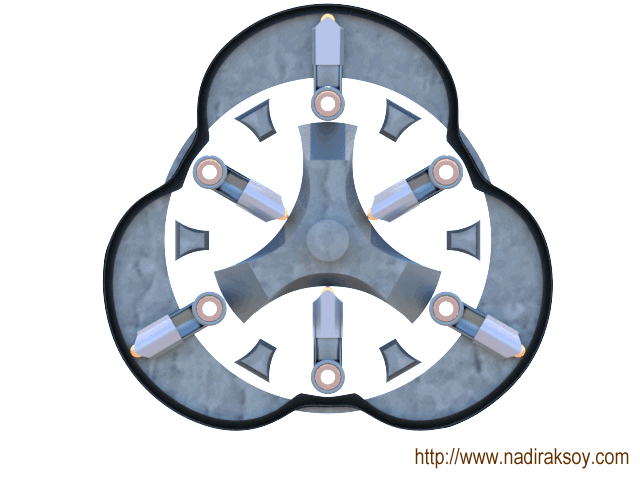
This invention is not just about petroleum products. In fact, what is done with this invention is the process of turning linear motion into circular motion with a high torque value. So, it is not just about internal combustion engines.Since circular motion is formed with high torque it can also be a used as an external combustion engine (Stirling engine, etc.).Also, it can be a compressed air-powered engine. With the resulting high torque, two important problems of compressed air engines have been eliminated. Range and noise.It can also be used more efficiently in piston compressors.
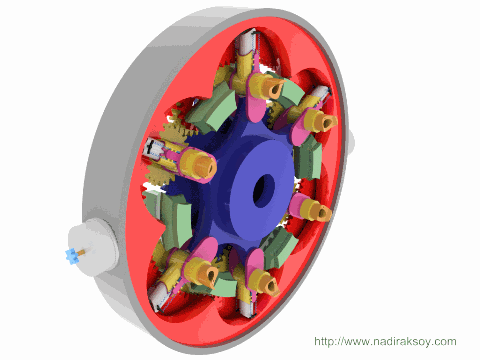
It can also be used with renewable alternative fuels such as biodiesel.In my invention, natural gas is more efficient because it has a constant combustion stroke. At a high compression ratio, there is no knock on the engine. Because of the geometric shape of the rails, the piston can move to the upper dead point in a very short time.For example, ammonia can be used efficiently in this engine. Because, as mentioned above, there is an independent combustion stroke. Ammonia, which has a low combustion rate, will be able to combustion more efficiently even at high engine speeds in the constant combustion process. In conventional internal combustion engines, no efficient operation was achieved with ammonia alone. But in these inventions, ammonia, which is much more economical, can be used efficiently. At the same time, carbon is not released outside. In addition, ammonia will also be used for cooling, so there will be no need for a cooling device.
In conventional internal combustion engines, hydrocarbon (HC) seen in the exhaust gas at the end of combustion in cylinders indicates low thermal efficiency. The reason CO (carbon monoxide) is found in the exhaust gas is that during the bad combustion process in the cylinder, the fuel molecule is combined with 1 oxygen instead of 2 due to lack of oxygen. The reason for this is that the fuel is partially combustion. Factors that prevent complete combustion of fuel are that the fuel-air mixture ratio during combustion time is not stable in different parts of the cylinder, the combustion event occurs at a variable and unstable volume, pressure, and temperature, and there is not enough time for complete combustion. However, when complete combustion is achieved in the internal combustion engine, non-harmful carbon dioxide and water come out of the exhaust.
In addition to this disadvantage, the problem that the highest pressure obtained can be transferred to the output shaft with only a very small torque angle is added, which further reduces thermal efficiency along with mechanical efficiency.
The part that causes these two most important problems (partial combustion and small torque angle) is the crankshaft. The crankshaft is not an accurate and efficient part in converting linear/circular motion to each other in internal/external combustion piston engines and mechanisms.
In this case, the solution to the first problem will be possible by creating a combustion time/stroke independent of other strokes and a combustion chamber of constant volume at the end of the compression stroke. Here, the fuel can be completely combusted at a time when the piston can remain stationary while the engine continues to move. In this way, the necessary conditions will be provided for the realization of full combustion. The stable fuel-air mixture in each area of the combustion chamber, constant volume/pressure/temperature, and sufficient time during combustion time.
The solution to the second problem will be possible by transferring the piston’s combustion end pressure from the beginning to the end of the power stroke to the output shaft with a different and independent part/mechanism than the connecting rod mechanism to which it is connected.
In this invention, the crankshaft was not used and the solution of the two problems mentioned above was combined. In the combustion process, which is independent of the other four strokes, when the piston speed is zero despite the engine rotation, the highest pressure obtained at the end of full combustion is transferring to the piston with the highest torque angle, and then to the inner rail and/or outer rail.
In this case, the solution to the first problem will be possible by creating a combustion time/stroke independent of other strokes and a combustion chamber of constant volume at the end of the compression stroke. Here, the fuel can be completely combusted at a time when the piston can remain stationary while the engine continues to move. In this way, the necessary conditions will be provided for the realization of full combustion. The stable fuel-air mixture in each area of the combustion chamber, constant volume/pressure/temperature, and sufficient time during combustion time.
The solution to the second problem will be possible by transferring the piston’s combustion end pressure from the beginning to the end of the power stroke to the output shaft with a different and independent part/mechanism than the connecting rod mechanism to which it is connected.
In this invention, the crankshaft was not used and the solution of the two problems mentioned above was combined. In the combustion process, which is independent of the other four strokes, when the piston speed is zero despite the engine rotation, the highest pressure obtained at the end of full combustion is transferring to the piston with the highest torque angle, and then to the inner rail and/or outer rail.
This invention has two very important differences from traditional internal combustion engines:
1. It has a combustion time independent of the other four strokes. During the combustion time, the piston speed is zero while the engine continues to rotate. So, this engine is a five-stroke engine, as it should be. In this way, a very high thermal efficiency is achieved by providing complete combustion. In this way, less specific fuel consumption is possible while obtaining more power, and harmful emissions are eliminated. In this way, complete combustion of alternative and/or renewable fuels that need a certain combustion time can be achieved. In addition, in the internal combustion engine, where argon gas will be used as an expansion gas, the difficulty of timing the injection of hydrogen into the cylinder has been eliminated.
2. By transferring the highest pressure obtained at the end of complete combustion to the output shaft with the highest torque angle, both thermal efficiency and mechanical efficiency are increased. In this way, on the one hand, more power is obtained, and on the other hand, less specific fuel consumption is possible.
This invention goes far beyond trying to start an internal combustion engine with different kinematics. That kind of hobby works was already done 20 years ago.
As clearly explained in the presentation in the link below, this invention, which has these two important features that are not found in traditional internal combustion engines, has been described as a new generation, environmentally friendly, and sustainable internal combustion engine.
According to the improvements achieved by this invention, it will be possible to use renewable fuels and oil-derived fuels more efficiently to close the gap in electric vehicles that will not meet climate targets alone for the next decades.
Contact Us
Üniversiteler Mah. 1596 Cad. Teknokent Kuluçka Merkez Binası No: 6 C İç Kapı No: 10/B1 Çankaya/ ANKARA
